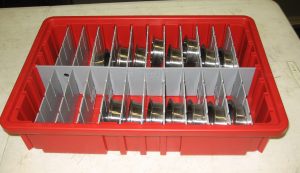 When it comes to packaging parts, we’ve seen it all. Parts that are too large or too heavy for a cardboard box – yet they are still in a box, sides smashed and the bottom giving out. Parts that are loosely stacked on top of each other, sometimes machined parts with finished surfaces against each other. Skids of parts that are not banded or wrapped properly to prevent shifting. Even skids that are not banded or wrapped at all!
When it comes to packaging parts, we’ve seen it all. Parts that are too large or too heavy for a cardboard box – yet they are still in a box, sides smashed and the bottom giving out. Parts that are loosely stacked on top of each other, sometimes machined parts with finished surfaces against each other. Skids of parts that are not banded or wrapped properly to prevent shifting. Even skids that are not banded or wrapped at all!
Now these parts have arrived in your receiving department, and you’re left scratching your head. Did you plan enough time in the job to allow for a thorough incoming inspection to determine what’s good and what’s bad? Will the parts damaged in transit still be usable? Do you call the supplier, the customer, the freight company? If you don’t make a call, will you get a call? Perhaps most importantly, who assumes the responsibility for damaged parts?
As the Miami Valley moves more and more into the high tech fields of research, medical devices, and aerospace (just to name a few), the products manufactured here need comparable attention to shipping, receiving, and in process handling. When parts move through departments and vendor facilities during the various manufacturing stages, having proper containers and protection saves time, money, and aggravation.
With thousands of parts moving through our facility each week, we have the opportunity to see which customers are seasoned to this line of thinking, and unfortunately, which one’s are not. We’ve implemented incoming and pre-shipping quality inspections in order to reduce our liability AND improve our service level by alerting customers to any damages or shortages up front.
When parts arrive in containers with dividers and lids, it’s easy to get a part count and perform a damage/quality inspection. Some customers sending parts on a repetitive basis have gone as far as making special shipping/handling containers that protect their goods. These are the ones that rarely have any damage to report. However, there are also customers that may not see the benefits of packaging or simply don’t want to bother with it. These are the jobs that require additional phone calls, emails containing photos of damaged parts, and worst of all, time spent trouble shooting that is never planned or accounted for.
If you’re a manufacturer and you haven’t done so already, it may be worth your while to investigate proper part packaging. If you’re a service provider, don’t be afraid to contact your customers and vendors if you are dealing with packaging problems. It may be a simple oversight. Making them aware can be an easy solution, and showing them you care with this added step of customer service can really pay off!